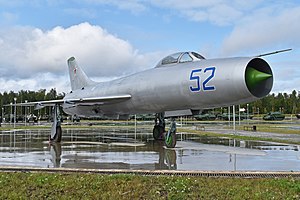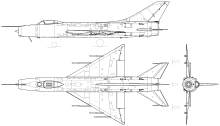Sukhoi Su-9
| Su-9 | |
|---|---|

| |
| Role | Interceptor aircraft |
| National origin | Soviet Union |
| Manufacturer | Sukhoi |
| First flight | June 24, 1956 |
| Introduction | 1959 |
| Retired | 1970s |
| Primary user | Soviet Air Defense Forces
|
| Number built | 1,150 |
| Developed from | Sukhoi T-3 |
| Variants | Sukhoi Su-11 |
The Sukhoi Su-9 (
Development

The Su-9 emerged from aerodynamic studies by
The total production of the Su-9 was about 1,100 aircraft. It is believed that at least some Su-9s were upgraded to Su-11 "Fishpot-C" form. None were exported to any of the USSR's client states nor to the Warsaw Pact nations. The remaining Su-9s and later Su-11s were retired during the 1970s. Some were retained as test vehicles or converted to remote-piloted vehicles for use as unmanned aerial vehicles. It was replaced by the upgraded Su-11 and the much-superior Su-15 "Flagon" and MiG-25 "Foxbat".
The combat record of the "Fishpot" is poorly documented. It is possible that it was involved in the interception (or even shoot-down) of reconnaissance missions, but no information has been publicly declassified.
Being an interceptor, the Su-9 was used in routine patrols and interdictions over the Soviet Frontiers. The most widely known involved in the interception of Francis Gary Powers' U-2 on Soviet territory on May 1, 1960. The Su-9 was unarmed and was directed to ram the U-2. One ramming attempt was made, but the Su-9 missed the U-2 due to the significant difference in the speed of the two planes. Due to the Su-9's lack of fuel, the pilot elected to break away from the U2 and continue with the original flight plan. Its pilot, Captain Igor Mentyukov, later claimed that his slipstream caused the U-2 to break apart. He discounts the official version that the U-2 was shot down by an
On September 4, 1959 a modified Su-9 (designated T-431 by the bureau) piloted by
Bobrovka became the Soviet Union's primary storage facility for the Su-9 as it was phased out, and by 1981 at least 243 Su-9 aircraft were observed parked at Bobrovka.[2]
Design

The Su-9's fuselage and tail surfaces resembled those of the Su-7, but unlike the
The Su-9 was developed from earlier work on a developmental aircraft designated T-3, to which the Su-9 was nearly identical. Internally at Sukhoi, the Su-9 was known as the T-43.
The delta wing of the Su-9 was adopted because of its lower
The Su-9 had primitive R1L (
A two-seat trainer version designated Su-9U was also produced in limited numbers (about 50 aircraft). It received the NATO reporting name "Maiden." It had a full armament and radar system with displays in both cockpits, allowing trainees to practice all aspects of the interception mission. Still, because the second seat further reduced the already meager fuel fraction, it was not genuinely combat-capable.
The Su-9 has been frequently mistaken for the MiG-21 due to the many similarities in design. The primary distinguishing features are the Su-9's size and its bubble canopy.
Variants
- Development of the Su-9.
- T-405
- Prototype model of the Su-9.
- Su-9
- Production variant, about 1,100 built.
- Su-9U
- Training variant, mounting the standard avionics suite without weapon systems or hardpoints. About 50 units were manufactured.
- T-431
- A specially modified Su-9 for setting the world record for absolute height in 1962.
- Sukhoi Su-11
- A upgraded design based on the Su-9. It was slightly lengthened compared to the Su-9. However, it was outmoded by the Sukhoi Su-15, which offered vastly increased range and aerodynamic performance.
- Sukhoi Su-17
- Is the first Sukhoi design to incorporate a Variable-sweep wing. The Su-17 was designed in parallel with the Su-11 but was delayed until the wing-sweeping mechanism was ready. The Su-17 exists in numerous variations and was exported to Warsaw Pact nations and other nations such as Peru.
Operators
- Soviet Anti-Air Defense
- 894th Fighter Aviation Regiment, Ozernoye, Ukraine, 1959-1979.[3]
Specifications (Su-9)

Data from OKB Sukhoi : a history of the design bureau and its aircraft [4]
General characteristics
- Crew: 1 (Su-9U 2)
- Length: 16.772 m (55 ft 0 in)
- Wingspan: 8.536 m (28 ft 0 in)
- Height: 4.82 m (15 ft 10 in)
- Wing area: 34 m2 (370 sq ft)
- Empty weight: 7,675 kg (16,920 lb)
- Landing weight: 8,658 kg (19,088 lb)
- Gross weight: 10,755 kg (23,711 lb)
- Max takeoff weight: 12,512 kg (27,584 lb)
- Fuel capacity: 3,100 kg (6,834 lb) internal + 2,160 kg (4,762 lb) in external tanks
- Powerplant: 1 × afterburning turbojetengine, 66.67 kN (14,987 lbf) thrust dry, 94.12 kN (21,158 lbf) with afterburner
Performance
- Maximum speed: 2,120 km/h (1,320 mph, 1,140 kn) / Mach 2.0 at 13,000 m (43,000 ft)
- 2,230 km/h (1,390 mph; 1,200 kn) over 13,000 m (43,000 ft)
- Landing speed: 305–310 km/h (190–193 mph; 165–167 kn)
- Range: 1,350 km (840 mi, 730 nmi) internals
- Ferry range: 1,800 km (1,100 mi, 970 nmi) with external tanks
- Endurance: 1 hour 18 minutes on internal fuel
- 2 hours with external tanks
- Service ceiling: 20,000 m (66,000 ft)
- g limits: +7
- Wing loading: 316 kg/m2 (65 lb/sq ft)
- Thrust/weight: 0.89
- Landing run: 1,150–1,250 m (3,770–4,100 ft) without brake parachute
Armament
- Hardpoints: 2 × under-fuselage hardpoints for drop tanks and 4 × under-wing hardpoints for 500 kg (1,100 lb) of disposable stores[5] , with provisions to carry combinations of:
- Missiles: 4 × K-5 air-to-air missiles
See also
Related development
Aircraft of comparable role, configuration, and era
- English Electric Lightning
- Convair F-106 Delta Dart
- Lockheed F-104 Starfighter
- Dassault Mirage III
- Saab 35 Draken
- Mikoyan-Gurevich MiG-21
- CAC CA-23
References
- ^ "F-4 A Phantom, 16 world records - The Greatest Military Aircraft? Forum - AirSpace". www.flightglobal.com. Archived from the original on 2008-07-02.
- ^ PHASEOUT OF FISHPOT IN APVO STRANYY AIRFIELDS USSR Archived 2020-07-29 at the Wayback Machine, February 1981, CREST: CIA-RDP81T00380R000100980001-5, Central Intelligence Agency, Washington, DC.
- ^ Michael Holm, http://www.ww2.dk/new/air%20force/regiment/iap/894iap.htm, accessed December 2012.
- ISBN 9781857800128.
- ^ www.3ebra.com, IT-Bureau Zebra -. "Sukhoi Company (JSC) - Airplanes - Museum - Su-9, 11, 13 - Specifications". www.sukhoi.org. Archived from the original on 2017-09-25. Retrieved 2017-09-25.
{{cite web}}: CS1 maint: numeric names: authors list (link)
